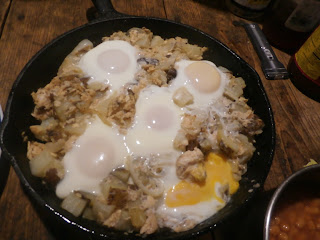We love canned sweet potatoes and because we live in the South, we can get them at a very good price around August or September every year. I buy 2 of the 40# boxes each year so I’ll have plenty for over the winter. We like them baked, fried, as part of calico potatoes, and canned to use as a side dish or make sweet potato pies.
Getting them peeled and ready to can, though, is hard work. The USDA recommendation is to wash them and boil them whole for about 15 minutes, then peel them. I used to do that before we moved off grid, but bringing in water several times to wash them, boil them, then drain them and get them hot again, then make a syrup to can them in is more difficult now. So, I changed my tactics. I do still wash them, but then I peel them right away. I can use a lot less water in washing them, then I can cut them up and put them all in one big pot for parboiling. I parboil them about 7 to 10 minutes.
Here is my step-by-step of prepping sweet potatoes for canning. I do follow the pressure canning time and pressure guidelines from the USDA.
I use an apple peeler with the corer/slicer part pushed out of the way. This goes much faster and I only have to do a little trimming.
After trimming, I can cut them into chunks that will go into the jars. For this time I wanted to use regular mouth pint jars so they needed to be small enough to fit in there.
The directions called for 11 pounds of potatoes for 9 pints of canned potatoes. I’m pretty sure now that they meant UNpeeled potatoes because I wound up with at least twice the amount needed for one canner load. I double stacked them in the canner so there were 18 pints, but I was able to fill the canner twice like that!
I brought them to a boil and boiled them for about 10 minutes to get them hot throughout and to start them getting somewhat soft. The recommended canning time was developed using only hot, parboiled sweet potatoes. It was not developed using raw sweet potatoes.
I put them into hot jars, added a tablespoon of sugar and a 1/2 teaspoon of salt to each jar, then poured boiling water over them. (Both the sugar and salt are for flavor only and have nothing to do with safe preserving.) I removed the air bubbles, wiped the rims well, and put on hot lids and rings. I did this one jar at a time. As each jar was filled, I placed it back into the pressure canner where the other jars were heating up. I had jars for the top layer heated with boiling water in them set aside.
When the bottom layer was filled, I put in another rack and put more jars in the top layer. Then I put the canner lid on, tightened it down, brought up the heat, let it vent for 10 minutes after it had a full and steady stream of steam, tightened the regulator, brought it up to pressure, then processed the pints of sweet potatoes for 65 minutes.
This is the large canner I use to double stack pints or smaller.
From
Potatoes, Sweet - Pieces or Whole -- Safely canning sweet potatoes
After they were done and the pressure in the canner had dropped fully to 0, I took the jars out and put them on towels on the counter to cool. I don’t touch them for at least 12 hours. Then I check the seals, remove the rings, wash the jars, and write the product and date on the lid with a sharpie. I store them stacked in my tiny pantry area inside milk crates and with cardboard between layers. Stacking jars is okay according to both Ball and the NCHFP. Here’s what NCHFP says about it.
"If jars are stacked in storage, be careful not to disturb vacuum seals. It would be a good idea to not stack jars too high directly on top of each other; one manufacturer recommends no more than two layers high. It would be best to provide support between the layers as a preventive measure against disturbing the seals on the lower jars. Jars could be placed in boxes to be stacked, or use some type of a firm solid material across the jars as a supportive layer in between them."
-- From
Storing Home Canned Foods at the NCHFP (National Center for Home Food Preservation)
The end product: Beautiful and tasty home canned sweet potatoes.























































